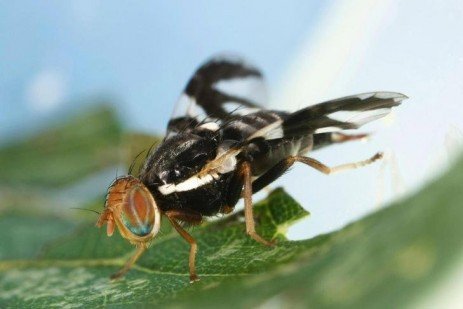
A destructive pest in commercial and backyard orchards alike, the apple maggot or Rhagoletis pomonella is native to the northeastern United States and is also known as the “railroad worm” due to the speed at which the maggots dig through the apple and the tunnels they create! While the larva resemble white, 1/4-inch maggots, adult flies have yellow legs and transparent wings with characteristic W-shaped dark bands. Contaminated fruits often show small dimples or pitted areas on the apple surface with brown or rotten trails running throughout the flesh along with an associated bacteria.

Infested apples drop prematurely and the mature maggots leave to pupate in the soil. In Pennsylvania, there is only one generation per year; the pupae overwinter in the ground until the following June, with peak emergence of new adult flies around July and August. Early maturing and thin-skinned apples are often most severely infested because it’s easier for the maggots to pierce the skin of the fruit to lay their eggs. Apple maggots will also attack plum, apricot, pear, cherry and hawthorn. If trees are neglected, 100% of the crop can be wormy rendering the fruit unfit for human consumption.

Apple Maggot Management
Luckily, there are a few ways to organically manage apple maggots in your orchard. The first is to collect and destroy dropped fruit daily until fall in order to prevent more maggots from breeding. In addition, adult flies may be trapped before they can lay eggs in new crops. Sticky red sphere traps such as these can be hung within bright spots in the canopy from early summer until harvest. It’s recommended to set out one trap for every 100-150 apples: six per full-size tree and one or two for dwarf trees.

Young fruits can be covered with plastic baggies or nylon footies to physically prevent insect pests from entering the fruit. They can even be made into an art installation such as this project in Seattle named “Blushing Orchards,” in which volunteers covered young apples with variously dyed “footies” that applied color theory to evoke a particular mood from each visitor to that orchard. Another strategy is to plant clover as a ground cover to attract beetles that will prey on the pupae in fallen fruits and the soil. If starting a new orchard, consider growing late-maturing cultivars as a prevention strategy. However, these methods will not be effective if infested, abandoned apple trees are nearby — ideally, abandoned apple trees and alternate hosts within 100 yards of the orchard should be removed.

Additional resources
- Penn State Extension
- Planet Natural
- The Organic Gardener’s Handbook to Natural Pest and Disease Control (Rodale)
This edition of POP TIPS prepared by 2019 POP Intern Piotr Wojcik.
SUPPORT US! If you found this entry useful, informative, or inspiring, please consider a donation of any size to help POP in planting and supporting community orchards in Philadelphia: phillyorchards.org/donate.